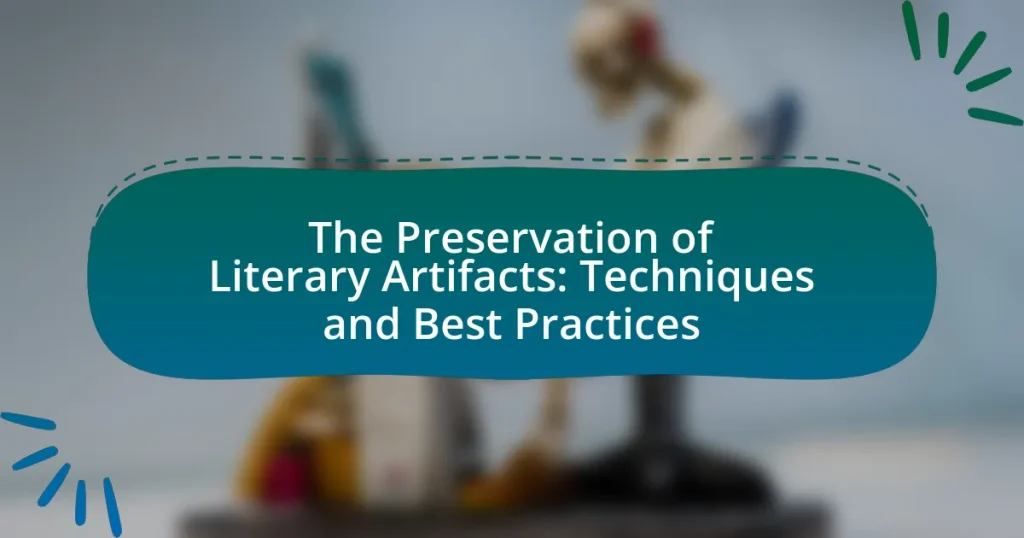Literary artifacts are significant physical objects that embody cultural, historical, or artistic value related to literature, including manuscripts, first editions, and letters. This article explores the importance of these artifacts in preserving cultural heritage, the various types that exist, and the challenges faced in their preservation, such as environmental degradation and human activities. It also discusses effective preservation techniques, including environmental control, digitization, and conservation methods tailored to different artifact types. Additionally, the article highlights best practices for individuals and institutions to ensure the longevity of literary artifacts, emphasizing the role of technology and community involvement in preservation efforts.

What are Literary Artifacts and Why are They Important?
Literary artifacts are physical objects that hold cultural, historical, or artistic significance related to literature, such as manuscripts, first editions, letters, and other documents. They are important because they provide insight into the context in which literary works were created, revealing the thoughts, intentions, and societal influences of authors. For example, the preservation of Shakespeare’s original folios allows scholars to study the evolution of his texts and understand the literary conventions of his time. Additionally, literary artifacts serve as tangible connections to the past, enriching our understanding of literary heritage and fostering appreciation for the evolution of language and storytelling.
How do Literary Artifacts contribute to cultural heritage?
Literary artifacts contribute to cultural heritage by preserving the language, values, and narratives of a society. These artifacts, such as manuscripts, books, and oral traditions, serve as tangible connections to the past, allowing future generations to understand their cultural identity. For instance, the preservation of ancient texts, like the Epic of Gilgamesh, provides insights into early human civilization, beliefs, and social structures. Furthermore, literary artifacts often reflect the historical context in which they were created, offering evidence of cultural evolution and societal changes over time. This preservation is crucial for maintaining a community’s collective memory and fostering a sense of belonging among its members.
What types of Literary Artifacts exist?
Literary artifacts include manuscripts, printed books, letters, diaries, and ephemera. Manuscripts are original handwritten texts, often significant for their historical value, while printed books represent the mass production of literature. Letters and diaries provide personal insights into the lives of individuals, contributing to biographical studies. Ephemera encompasses items like pamphlets and brochures that capture specific moments in time. Each type serves as a crucial resource for understanding cultural and historical contexts, as evidenced by the preservation efforts of institutions like the Library of Congress, which maintains a vast collection of these artifacts for research and education.
Why is the historical context of Literary Artifacts significant?
The historical context of literary artifacts is significant because it provides essential insights into the cultural, social, and political environments in which these works were created. Understanding the historical backdrop allows scholars and readers to interpret the themes, language, and intentions of the authors more accurately. For instance, literary works produced during periods of social upheaval, such as the American Civil War or the Industrial Revolution, often reflect the prevailing sentiments and struggles of that time, influencing their narrative and character development. This contextual analysis enhances the appreciation of the artifacts and informs preservation practices by highlighting the importance of maintaining the integrity of the original context in which these works were produced.
What challenges do we face in preserving Literary Artifacts?
The challenges faced in preserving literary artifacts include environmental degradation, physical deterioration, and technological obsolescence. Environmental factors such as humidity, temperature fluctuations, and light exposure can lead to mold growth, fading, and material breakdown. For instance, paper artifacts can become brittle and yellowed due to improper storage conditions. Physical deterioration occurs from handling, which can cause wear and tear, while technological obsolescence affects digital literary artifacts, as formats and software may become outdated, making access and preservation difficult. According to the Library of Congress, over 90% of recorded sound and video is at risk of being lost due to these challenges, highlighting the urgency of effective preservation strategies.
How do environmental factors affect Literary Artifacts?
Environmental factors significantly affect literary artifacts by influencing their physical condition and longevity. Factors such as temperature, humidity, light exposure, and air quality can lead to deterioration, mold growth, fading, and structural damage. For instance, high humidity levels can cause paper to warp and ink to run, while excessive light can fade colors and weaken materials. Research conducted by the Library of Congress indicates that maintaining a stable environment with controlled temperature and humidity can extend the life of books and manuscripts by decades. Therefore, understanding and managing these environmental factors is crucial for the effective preservation of literary artifacts.
What role do human activities play in the degradation of Literary Artifacts?
Human activities significantly contribute to the degradation of literary artifacts through factors such as pollution, improper handling, and inadequate storage conditions. For instance, exposure to environmental pollutants can lead to chemical reactions that deteriorate paper and ink, while physical mishandling can cause tears and creases. Additionally, improper storage, such as high humidity or direct sunlight, accelerates the deterioration process. Studies have shown that artifacts stored in optimal conditions can last significantly longer than those subjected to neglect, highlighting the critical impact of human actions on their preservation.

What Techniques are Used in the Preservation of Literary Artifacts?
Techniques used in the preservation of literary artifacts include environmental control, digitization, and conservation treatments. Environmental control involves maintaining optimal temperature and humidity levels to prevent deterioration; for example, a relative humidity of 30-50% and a temperature of 65-70°F are often recommended for paper-based materials. Digitization allows for the creation of digital copies, which reduces the need for handling the original artifacts, thereby minimizing wear and tear. Conservation treatments, such as cleaning, mending, and deacidification, are applied to restore and stabilize artifacts, ensuring their longevity. These methods are supported by best practices established by organizations like the American Institute for Conservation, which emphasizes the importance of preserving the physical integrity of literary works while making them accessible for future generations.
How do conservation methods vary for different types of Literary Artifacts?
Conservation methods vary significantly for different types of literary artifacts, as each type requires tailored approaches based on its material composition and historical context. For instance, paper artifacts, such as manuscripts and books, often undergo deacidification and humidity control to prevent deterioration, while parchment requires specific treatments to maintain its flexibility and prevent brittleness. Additionally, digital literary artifacts necessitate methods like data migration and format preservation to ensure accessibility over time. The varying conservation techniques are supported by the fact that different materials respond uniquely to environmental factors, necessitating specialized knowledge and practices in the field of conservation.
What are the best practices for preserving paper-based artifacts?
The best practices for preserving paper-based artifacts include maintaining stable environmental conditions, using appropriate storage materials, and handling items with care. Stable environmental conditions involve keeping temperature and humidity levels consistent, ideally around 65-70°F and 30-50% relative humidity, to prevent deterioration. Appropriate storage materials, such as acid-free boxes and folders, protect artifacts from light, dust, and physical damage. Careful handling, including using gloves and supporting items properly, minimizes the risk of tears and creases. These practices are supported by guidelines from institutions like the Library of Congress and the American Institute for Conservation, which emphasize the importance of environmental control and proper materials in the preservation of paper artifacts.
How should digital Literary Artifacts be preserved?
Digital literary artifacts should be preserved through a combination of regular backups, format migration, and metadata documentation. Regular backups ensure that multiple copies exist in different locations, reducing the risk of data loss. Format migration involves transferring digital artifacts to current file formats to prevent obsolescence, as technology evolves rapidly and older formats may become unreadable. Additionally, thorough metadata documentation provides context and information about the artifacts, facilitating future access and understanding. These practices are supported by the Digital Preservation Coalition, which emphasizes the importance of these strategies in maintaining the integrity and accessibility of digital content over time.
What role does technology play in the preservation of Literary Artifacts?
Technology plays a crucial role in the preservation of literary artifacts by enabling digitization, which protects and enhances access to these works. Digitization allows for the creation of high-resolution images and text files, making it possible to store and share literary artifacts without risking damage to the originals. For instance, the Library of Congress has digitized millions of documents, ensuring their availability for future generations while minimizing physical handling. Additionally, technologies such as climate control systems and advanced materials for storage help maintain optimal conditions for the preservation of physical artifacts, further safeguarding their integrity.
How can digitization aid in the preservation process?
Digitization aids in the preservation process by creating high-quality digital copies of literary artifacts, which reduces physical handling and deterioration of the originals. This method allows for easier access and sharing of materials while ensuring that the content is preserved in a stable format, mitigating risks associated with environmental factors such as light, humidity, and temperature. Studies have shown that digitized materials can be stored indefinitely without the degradation that physical items experience over time, thus extending the lifespan of literary works. For instance, the Library of Congress has digitized millions of items, providing a model for how digitization can effectively safeguard cultural heritage while making it accessible to a global audience.
What are the limitations of using technology for preservation?
The limitations of using technology for preservation include issues of accessibility, cost, and the potential for obsolescence. Accessibility can be a barrier, as not all institutions or individuals have the resources to implement advanced technological solutions, which can lead to unequal preservation efforts. The cost of technology can be prohibitive, with high initial investments required for equipment and ongoing maintenance expenses. Additionally, technological formats can become obsolete, risking the loss of access to preserved materials if the technology is not updated or if data formats are no longer supported. For instance, digital files may become unreadable if software or hardware changes significantly over time, as seen with early digital formats that are now difficult to access.

What are the Best Practices for Preserving Literary Artifacts?
The best practices for preserving literary artifacts include maintaining controlled environmental conditions, using appropriate storage materials, and implementing careful handling procedures. Controlled environments should have stable temperature and humidity levels, ideally around 65-70°F and 30-50% relative humidity, to prevent deterioration. Appropriate storage materials, such as acid-free boxes and archival-quality folders, protect artifacts from physical damage and chemical reactions. Careful handling procedures involve using gloves, supporting fragile items, and minimizing exposure to light, which can cause fading and degradation. These practices are supported by guidelines from institutions like the Library of Congress and the American Institute for Conservation, which emphasize the importance of environmental stability and proper materials in the preservation of historical documents and literary works.
How can institutions implement effective preservation strategies?
Institutions can implement effective preservation strategies by developing comprehensive preservation plans that include environmental controls, proper storage, and regular condition assessments. These plans should prioritize maintaining optimal temperature and humidity levels to prevent deterioration, as studies show that fluctuations can significantly damage literary artifacts. Additionally, institutions should utilize archival-quality materials for storage and display, ensuring that items are protected from light exposure and physical handling. Regular training for staff on preservation techniques and the use of conservation professionals for high-value items further enhances the effectiveness of these strategies.
What training is necessary for professionals involved in preservation?
Professionals involved in preservation require specialized training in conservation techniques, materials science, and archival practices. This training typically includes formal education in fields such as library science, history, or art conservation, often culminating in a master’s degree or equivalent certification. Additionally, hands-on experience through internships or apprenticeships in museums, libraries, or conservation labs is essential for developing practical skills. According to the American Institute for Conservation, ongoing professional development and adherence to ethical standards are also critical components of effective preservation training.
How can community involvement enhance preservation efforts?
Community involvement enhances preservation efforts by fostering local engagement and support for cultural heritage initiatives. When communities actively participate, they contribute valuable knowledge about local history and traditions, which can inform preservation strategies. For instance, community-led projects often result in increased funding and volunteer support, as seen in the case of the “Save Our Libraries” campaign in the United States, where local citizens raised over $1 million to preserve library resources. Additionally, community involvement can lead to greater awareness and appreciation of literary artifacts, ensuring their protection for future generations. This collaborative approach not only strengthens the preservation efforts but also builds a sense of ownership and responsibility among community members.
What are some common mistakes to avoid in the preservation of Literary Artifacts?
Common mistakes to avoid in the preservation of literary artifacts include improper handling, inadequate environmental controls, and neglecting documentation. Improper handling can lead to physical damage, such as tears or creases, which can be prevented by using gloves and supporting materials. Inadequate environmental controls, such as fluctuating temperature and humidity, can accelerate deterioration; maintaining stable conditions is essential for longevity. Neglecting documentation, including provenance and condition reports, can hinder future preservation efforts and research, making it crucial to maintain thorough records for each artifact.
How can improper handling damage Literary Artifacts?
Improper handling can damage literary artifacts by causing physical deterioration, such as tears, creases, or loss of material. For instance, excessive pressure during handling can lead to paper degradation, while exposure to oils from hands can result in staining or discoloration. Studies have shown that artifacts exposed to improper environmental conditions, such as fluctuating humidity and temperature, are more susceptible to damage, further emphasizing the need for careful handling practices.
What are the risks of using inappropriate materials for preservation?
Using inappropriate materials for preservation can lead to irreversible damage to literary artifacts. Such materials may cause chemical reactions that deteriorate the original substance, resulting in discoloration, brittleness, or loss of structural integrity. For instance, acidic paper can accelerate degradation in books, while non-archival adhesives can leave residues that harm the item over time. Additionally, inappropriate materials may not provide adequate protection against environmental factors like humidity and light, further compromising the artifact’s longevity.
What practical tips can individuals follow to preserve Literary Artifacts at home?
To preserve literary artifacts at home, individuals should store items in a controlled environment with stable temperature and humidity levels. Maintaining a temperature between 65-70°F and humidity around 40-50% helps prevent deterioration. Additionally, using acid-free storage materials, such as boxes and folders, protects against chemical damage. Avoiding direct sunlight and using UV-filtering glass for display can prevent fading and discoloration. Regularly handling artifacts with clean hands or gloves minimizes oils and dirt transfer, further preserving their condition. These practices are supported by guidelines from institutions like the Library of Congress, which emphasize the importance of environmental control and proper handling in artifact preservation.


